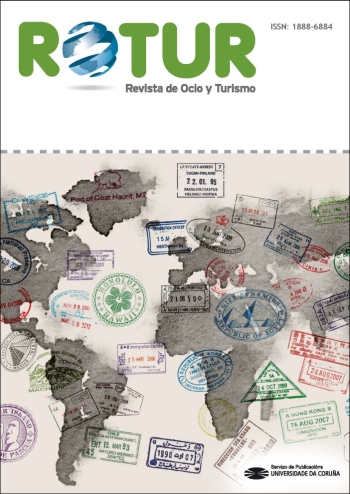El impacto de las restricciones de visado en la llegada de turistas internacionales
Contenido principal del artículo
DOI:
https://doi.org/10.17979/rotur.2023.17.2.9483Resumen
Este estudio evalua el impacto de las restricciones de visado en la llegada de turistas internacionales para el periodo 2017-2019. A pesar de la relevancia del tema, existen pocos estudios en la literatura económica que analicen hasta qué punto las restricciones de visado reducen el flujo de viajeros entre países. Este trabajo pretende suplir esta escasez de estudios, puesto que las restricciones de visados suponen una importante barrera para los movimientos internacionales de turistas limitando el desarrollo del sector e impidiendo lograr el crecimiento económico y la reducción del desempleo. Por tanto, el principal objetivo de esta investigación es explorar el efecto que diferentes tipos de visados tienen sobre el turismo y la toma de decisiones por parte de los gobiernos sobre su política de visados. Para abordar este análisis, el presente estudio clasifica los diferentes tipos de visados en visa tradicional, visa electrónica y visa obtenida a la llegada al país de destino. En el análisis empírico se define un modelo de gravedad para estimar los movimientos turísticos bilaterales con los métodos de estimación OLS y PPML en tres modelos diferentes: el primer modelo considera efectos fijos de origen, destino y año, el segundo considera resistencias multilaterales y, el último incluye conjuntamente resistencias multilaterales y efectos fijos de par. En cuando a las estimaciones obtenidas para las variables de interés, la visa tradicional tiene el efecto más perjudicial, suponiendo una reducción del 21.2% de las entradas de turistas, mientras que la visa a la llegada es la menos perjudicial con un efecto entre el 10.7% OLS y el 13.1% PPML. Por tanto, se demuestra que los gobiernos deben evaluar todos los costes de las políticas de visados, incluyendo el efecto que tienen sobre el turismo, y estudiar los beneficios de una flexibilización de estas políticas.
Palabras clave:
Detalles del artículo
Referencias
Adam, Christopher y Cobham, David (2007). Modelling multilateral trade resistance in a gravity model with exchange rate. Centre for Dynamic Macroeconomic Analysis.
Addullah, Karaman (2016). The pernicious impact of visa restrictions on inbound tourism: the case of Turkey. Turkish Studies, 17(3), 502-524. https://doi.org/10.1080/14683849.2016.1170602
Artal-Tur, Andrés; Pallardó-López, Vicente y Requena-Silvente, Francisco (2016). Examining the impact of visa restrictions on international tourist flows using panel data: Un análisis con datos de panel. Estudios de Economía, 43(2), 265-279. https://doi.org/10.4067/s0718-52862016000200005
Çakar, Kadir; Kalbaska, Nadzeya; Inanir, Ali y Şahin Ören, Tuba (2018). eVisa’s impacts on travel and tourism: the case of Turkey. Journal of Hospitality and Tourism Technology, 9(1), 14-32. https://doi.org/10.1108/JHTT-02-2017-0019
Cheng, I.-Hui y Wall, Howard. (2005). Controlling for Heterogeneity in Gravity Models of Trade and Integration. Review, 87(1), 49-64. https://doi.org/10.20955/r.87.49-64
Correia, Sergio; Guimarães, Paulo y Zylkin, Thomas (2019a). PPMLHDFE: Fast Poisson Estimation with High-Dimensional Fixed Effects, 20(1), 95-115. https://arxiv.org/pdf/1903.01690.pdf
Correia,Sergio; Guimarães, Paulo y Zylkin, Thomas (2019b). Verifying the existence of maximum likelihood estimates for generalized linear models. https://arxiv.org/pdf/1903.01633.pdf
Czaika, Mathias y De Haas, Hein (2017). The Effect of Visas on Migration Processes. International Migration Review, 51(4), 893-926. https://doi.org/10.1111/imre.12261
Czaika, Mathias y Neumayer, Eric (2017). Visa restrictions and economic globalization. Applied Geography, 84, 75-82. https://doi.org/10.1016/j.apgeog.2017.04.011
Deutschmann, Emanuel; Gabrielli, Lorenzo; Kholmatova, Nodira y Recchi, Ettore (2021). The global visa cost divide: How and why the price for travel permits varies worldwide. Political Geography, 86. https://doi.org/10.1016/j.polgeo.2021.102350
Gómez-Herrera, Estrella (2011). Comparing alternative methods to estimate gravity models of bilateral trade. Empir Econ, 44, 1087–1111. https://doi.org/10.1007/s00181-012-0576-2
Kimura, Fukunari y Lee, Hyun-Hoon (2006). The Gravity Equation in International Trade in Services. Review of World Economics / Weltwirtschaftliches Archiv, 142 (1), 92–121. http://www.jstor.org/stable/40441082
Lawson, Robert y Roychoudhury, Saurav (2016) Do travel visa requirements impede tourist travel?. J Econ Finan, 40(4), 817-828. https://doi.org/10.1007/s12197-015-9343-5
Lisner, David; Rejesus, Roderick y Yasar, Mahmut (2012). Bilateral trade impacts of temporary foreign visitor policy. Rev World Econ, 148 (1), 501-521 https://doi.org/10.1007/s10290-012-0122-5
Mau, Steffan; Gulzau, Fabian; Laube, Lene y Zaun, Natascha (2015) The globall mobility dive: How visa policies have evolved over time. Journal of Ethnic and Migration Studies, 41 (8), 1192-1213. https://doi.org/10.1080/1369183X.2015.1005007
McKay, Andy y Tekkleselassie, Tsegay (2018) Tall paper walls: The political economy of visas and cross‐border travel. World Economics, 41(11), 2914–2933. https://doi.org/10.1111/twec.12686
Neumayer, Eric (2006). Unequal Access to foreign spaces: how states use visa restrictions to regulate mobility in a globalized world. Vital Geography, 31(1), 72-84. https://doi.org/10.1111/j.1475-5661.2006.00194.x
Neumayer, Eric (2010). Visa Restrictions and Bilateral Travel. The Professional Geographer, 62(2), 171-181. https://doi.org/10.1080/00330121003600835
Neumayer, Eric. (2011). On the detrimental impact of visa restrictions on bilateral trade and foreign direct investment. Applied Geography, 31(3), 901-907. https://doi.org/10.1016/j.apgeog.2011.01.009
Reilly, Barry y Tekleselassie, Tsegay (2018). The role of United States Visa Waiver Program on cross-border travel. Applied Economics Letters, 25(1): 61-65. https://doi.org/10.1080/13504851.2017.1293782
Rosselló, Jaume y Santana-Gallego, María (2022). Gravity models for tourism demand modelling. Applied Economics Letters, 36 (5), 1– 52. https://doi.org/10.1111/joes.12502
World Tourism Organization (2012). Visa facilitation can create five million additional jobs in G20 economies. PR No. PR12031.
World Tourism Organization (2013). Tourism Visa openness report: visa facilitation as means to stimulate tourism growth, UNWTO. https://www.e-unwto.org/doi/epdf/10.18111/9789284415731
World Tourism Organization (2016), Visa Openness Report 2015, UNWTO. https://doi.org/10.18111/9789284417384
World Tourism Organization (2018). World Tourism Barometer and Statistical Annex, UNWTO. https://doi.org/10.18111/wtobarometereng
World Tourism Organization (2019). International Tourism Highlights 2019, UNWTO. https://www.e-unwto.org/doi/epdf/10.18111/9789284421152
World Travel and Tourism Council (2019), Benchmarking Research Trends 2019, WTTC. https://wttc.org/Portals/0/Documents/Reports/2019/Benchmarking%20Trends%20Report%202019.pdf?ver=2021-02-25-182807-540
World Tourism Organization (2022). El turismo internacional consolida su fuerte recuperación en medio de crecientes desafíos, UNWTO. https://www.unwto.org/es/taxonomy/term/347
World Tourism Organization (2022). World Tourism Barometer and Statistical Annex, UNWTO. https://doi.org/10.18111/wtobarometereng


